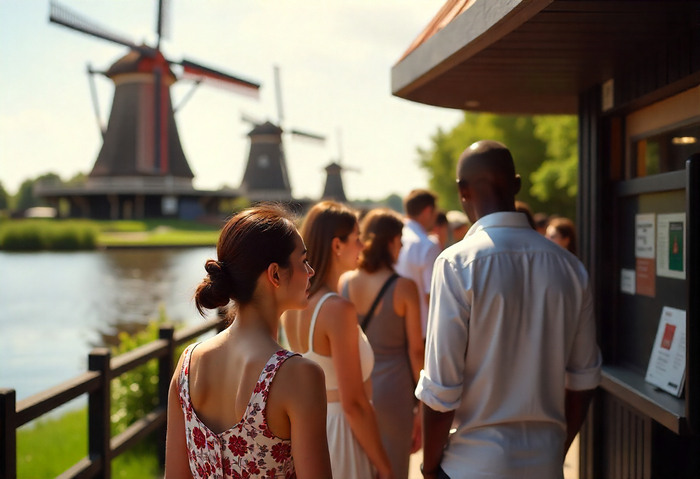Published on
October 6, 2025
The Netherlands is implementing bold measures to tackle the pressures of mass tourism with a new pre-booked ticket system at Zaanse Schans and key attractions in Amsterdam. These world-famous destinations, celebrated for their historic windmills, vibrant tulip fields, and rich cultural heritage, have struggled with overwhelming visitor numbers that strain local infrastructure and disrupt community life. The innovative system is designed to manage crowd levels, fund maintenance of cultural sites, and maintain a sustainable balance between tourism and the everyday life of residents, setting a benchmark for responsible travel while still offering an unforgettable visitor experience.
Zaanse Schans, a charming village just north of Amsterdam, will begin charging an entry fee of €17.50 (£15.25) from spring 2026. Long admired for its traditional Dutch architecture, working windmills, and scenic tulip fields, the village attracts millions of tourists seeking an authentic glimpse of Dutch heritage. The introduction of the ticket reflects the need to control visitor volumes, protect the village’s cultural landmarks, and safeguard the quality of life for its small local population, ensuring that Zaanse Schans remains both a vibrant community and a world-class tourist destination.
The entry fee will be for pre-booked tickets and will provide access to the village’s main attractions, including the local museum and the interiors of its windmills, which were previously charged individually. By consolidating access under a single ticket, local authorities aim to streamline visitor experiences while generating funds necessary to maintain and protect the village’s historic sites. These funds are earmarked for windmill restoration, infrastructure improvements, and enhancements to visitor amenities such as parking facilities, public restrooms, and signage.
Zaanse Schans is a unique “living museum,” home to roughly 100 permanent residents, yet it attracts millions of tourists annually. In 2024 alone, the village welcomed around 2.6 million visitors. The influx has put significant pressure on local infrastructure and posed challenges to residents’ privacy and day-to-day life. The growing crowds have led to congestion on narrow streets, overuse of facilities, and frequent encounters between tourists and residents that can disrupt daily routines.
The village has historically served as a popular day-trip destination for travelers based in Amsterdam. Visitors are drawn to the charm of traditional Dutch houses, artisan workshops, cheese farms, and the opportunity to see windmills in action. While tourism provides an essential economic boost, authorities have acknowledged that unregulated numbers risk undermining the very qualities that make the village attractive. Introducing the entry fee is seen as a strategic measure to moderate visitor flows and maintain a sustainable balance between tourism and community life.
In recent years, concerns over overcrowding and the negative impact of mass tourism have intensified across the Netherlands. Amsterdam, in particular, has seen rapid growth in tourist numbers, prompting activism and calls for stricter regulatory measures. In September 2025, a group of campaigners filed a formal complaint against Amsterdam city authorities to enforce existing rules aimed at limiting overnight stays for tourists. The complaint references a 2021 bylaw that caps annual overnight tourist stays at 20 million and requires proactive municipal action once numbers reach 18 million.
The campaign highlights the broader challenge cities face in managing tourism while preserving livability for residents. Activists argue that exceeding the cap not only strains infrastructure but also affects housing availability, local culture, and public services. By filing the complaint, campaigners seek to ensure that municipal authorities adhere to the law and implement practical measures to prevent excessive tourism pressure.
Zaanse Schans’ move to implement an entry fee reflects a similar trend toward sustainable tourism management. By generating funds from visitors, the village can invest in long-term preservation and infrastructure upgrades, ensuring that windmills, museums, and public spaces remain in good condition. At the same time, regulating visitor numbers helps protect residents’ quality of life, allowing them to maintain a sense of community in a location that attracts global attention.
Experts in tourism management note that such measures, while sometimes unpopular with travelers, are increasingly necessary in heritage sites experiencing heavy footfall. Entrance fees not only provide revenue but also act as a natural deterrent against overcrowding, encouraging more responsible travel and reducing wear on historic sites. For small communities like Zaanse Schans, balancing tourism revenue with sustainability is critical to ensuring that the village can continue to function as both a living community and a cultural destination.
Looking ahead, Zaanse Schans’ new policy may serve as a model for other high-traffic tourist destinations across the Netherlands and Europe. By combining financial sustainability with visitor management strategies, the village aims to preserve its historic charm while adapting to modern tourism pressures. Meanwhile, debates over mass tourism in Amsterdam and other Dutch cities continue, highlighting the delicate balancing act between attracting visitors and protecting the quality of life for residents.
For travelers, the introduction of the entry fee offers a more structured experience, granting access to multiple attractions while supporting the upkeep of one of the Netherlands’ most iconic heritage sites. As Zaanse Schans prepares to welcome visitors under this new system, the village is set to maintain its reputation as a must-visit destination, now with a stronger emphasis on sustainable tourism and community well-being.
